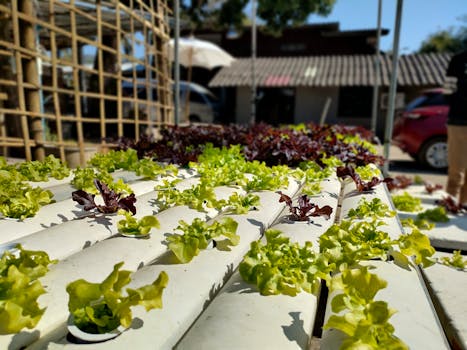Anúncios
Compreender o design agrícola é crucial para promover práticas sustentáveis e atender à demanda global por alimentos. Um bom design agrícola combina eficiência, inovação e responsabilidade ambiental.
O design agrícola envolve uma combinação de arquitetura, engenharia e gestão de terras para criar sistemas agrícolas produtivos. Essa integração aprimora a funcionalidade e a sustentabilidade da produção de alimentos.
À medida que mais pessoas reconhecem a importância da agricultura na vida cotidiana, compreender seus princípios de design torna-se essencial. Este artigo explorará as diversas facetas do design agrícola e sua importância na prática contemporânea.
Noções básicas de design agrícola
O design agrícola concentra-se no planejamento e na organização das operações agrícolas. Abrange o planejamento do espaço, a gestão de recursos e a consideração do ecossistema. Compreender esses princípios básicos é fundamental para o sucesso.
Um projeto agrícola eficaz considera o clima, os tipos de solo e a disponibilidade hídrica. Ele alinha o layout físico com as condições ambientais para maximizar a produtividade das culturas e, ao mesmo tempo, reduzir o desperdício de recursos.
Anúncios
Além disso, um bom design promove economias circulares ao integrar resíduos de volta ao sistema agrícola. A ênfase em designs formulados de forma otimizada garante a sustentabilidade e a produtividade na agricultura.
Os agricultores podem se beneficiar significativamente da tecnologia em projetos agrícolas. Ferramentas inovadoras como drones, sensores e softwares avançados melhoram a precisão e a eficiência na gestão de fazendas.
Em resumo, compreender os fundamentos do design agrícola permite maior produtividade e sustentabilidade. Essa compreensão cria sistemas melhores que atendem à economia e ao meio ambiente.
Anúncios
Elementos-chave do design de agricultura sustentável
O design agrícola sustentável é essencial para a saúde ambiental a longo prazo. Ele envolve vários elementos que trabalham harmoniosamente para criar um ecossistema agrícola equilibrado.
A rotação de culturas é um elemento fundamental do design sustentável. Essa prática ajuda a manter a fertilidade do solo e reduz pragas, resultando em uma produção agrícola mais saudável.
A gestão da irrigação também é crucial para projetos sustentáveis. O uso eficiente dos recursos hídricos evita o desperdício e garante que as culturas recebam hidratação adequada sem sobrecarregar os recursos locais.
A saúde do solo é um dos fundamentos da agricultura sustentável. Práticas como o cultivo de cobertura melhoram a estrutura do solo e enriquecem a matéria orgânica, beneficiando os ciclos de plantio futuros.
O envolvimento da comunidade é essencial no projeto de agricultura sustentável. O engajamento de stakeholders locais garante perspectivas diversas, levando a práticas agrícolas mais aceitas e eficazes.
Tecnologia Moderna em Design Agrícola
A tecnologia moderna revolucionou o design agrícola, impulsionando a eficiência e a sustentabilidade. Ferramentas como análise de dados, software GIS e automação estão abrindo caminho para soluções agrícolas mais inteligentes.
A agricultura de precisão ganhou impulso com a tecnologia moderna. O uso de imagens de satélite e dados de sensores permite que os agricultores tomem decisões informadas sobre a alocação de recursos.
Os drones agrícolas desempenham um papel vital no planejamento agrícola. Eles ajudam a monitorar a saúde das plantações, inspecionar grandes áreas e otimizar a distribuição de recursos, aprimorando a gestão geral da fazenda.
A automação é outro componente que está remodelando o design agrícola. Tecnologias como colheitadeiras robóticas podem aumentar a eficiência e reduzir os custos de mão de obra, garantindo, ao mesmo tempo, uma produtividade consistente.
De modo geral, a integração de tecnologia moderna ao design agrícola aumenta a eficácia das práticas agrícolas, resultando em maiores produtividades e melhores resultados de sustentabilidade para todo o setor.
O Papel da Agroecologia
A agroecologia enfatiza a relação entre agricultura e sistemas ecológicos. Ela promove práticas agrícolas sustentáveis por meio da integração de princípios ecológicos ao planejamento agrícola.
A diversidade de culturas é um princípio fundamental da agroecologia. O plantio de diversas espécies aumenta a resiliência e reduz a vulnerabilidade a pragas, doenças e impactos climáticos.
Os métodos agroecológicos frequentemente envolvem práticas de agricultura orgânica. A redução da dependência de fertilizantes e pesticidas sintéticos contribui para a saúde do solo e a biodiversidade.
O desenvolvimento de sistemas agroecológicos também se concentra na melhoria dos ecossistemas locais. A criação de habitats para organismos benéficos promove o controle natural de pragas e melhora a produtividade geral da fazenda.
Em última análise, a incorporação de princípios agroecológicos ao design agrícola leva a sistemas alimentares sustentáveis, resilientes e ecologicamente corretos.
Projetando para a resiliência climática
A resiliência climática é cada vez mais crucial no planejamento agrícola. À medida que as mudanças climáticas se intensificam, projetar fazendas que resistam a eventos climáticos extremos torna-se crucial para a sustentabilidade.
Uma maneira de aumentar a resiliência é por meio da diversificação de culturas e animais. Uma abordagem variada reduz o risco de perda total da colheita em condições adversas.
Além disso, estratégias de gestão hídrica são essenciais para projetos resilientes ao clima. A implementação de sistemas de coleta de água da chuva pode ajudar os agricultores a lidar com padrões de precipitação imprevisíveis.
Práticas de conservação do solo também desempenham um papel significativo. Manter a integridade do solo por meio de técnicas como cobertura morta e cultivo reduzido aumenta sua capacidade de absorver água e resistir à erosão.
Ao priorizar a resiliência climática no planejamento agrícola, os agricultores estão mais bem equipados para enfrentar mudanças nas condições ambientais e, ao mesmo tempo, garantir a segurança alimentar para as gerações futuras.
Design Agrícola Orientado pela Comunidade
O design agrícola orientado pela comunidade enfatiza o envolvimento local nos sistemas agrícolas. O envolvimento das comunidades locais nos processos de design promove a inclusão e a capacidade de resposta às necessidades locais.
Abordagens participativas no design agrícola aumentam a resiliência dos sistemas alimentares. O envolvimento da comunidade garante que as práticas sejam culturalmente relevantes e ambientalmente adequadas.
A colaboração entre diferentes partes interessadas é vital para um projeto de agricultura sustentável. Agricultores, governos locais e ONGs podem trabalhar juntos para implementar soluções eficazes e adaptadas aos contextos locais.
Programas de educação e treinamento nas comunidades fortalecem ainda mais o design agrícola. A construção de capacidade local garante que todos os participantes compreendam as práticas sustentáveis e seus benefícios.
Em última análise, o design agrícola conduzido pela comunidade leva a uma maior soberania alimentar, permitindo que as comunidades mantenham o controle sobre seus sistemas e cronogramas alimentares.
Conclusão
Compreender o design agrícola é essencial para alcançar operações agrícolas sustentáveis e produtivas. Cada elemento contribui para a criação de sistemas alimentares resilientes, capazes de enfrentar os desafios atuais e futuros.
Por meio de práticas sustentáveis, tecnologia moderna, agroecologia e engajamento da comunidade, o design agrícola pode melhorar a eficiência e, ao mesmo tempo, preservar o meio ambiente.
À medida que continuamos a nos adaptar às circunstâncias em mudança, o foco no design agrícola inovador e inclusivo garantirá a segurança alimentar para as gerações futuras.
Ao abordar essas áreas principais, podemos promover uma nova era na agricultura que promova a saúde ecológica, a equidade social e a viabilidade econômica.
Concluindo, uma compreensão abrangente do design agrícola é vital para todos os envolvidos na cadeia de produção de alimentos. Ela estabelece a base para um futuro sustentável na agricultura.
| Elemento | Importância |
|---|---|
| Rotação de culturas | Mantém a fertilidade do solo e reduz pragas. |
| Gestão de Irrigação | Evita o desperdício de água ao mesmo tempo que garante a hidratação da cultura. |
| Saúde do solo | Melhora os ciclos futuros de plantio e atenua a erosão. |
| Diversidade em Culturas | Aumenta a resiliência e reduz perdas por falhas. |
| Envolvimento da Comunidade | Garante que as práticas sejam culturalmente relevantes e aceitas. |
- Implementar práticas sustentáveis.
- Utilize tecnologia moderna para eficiência.
- Envolver comunidades em projetos agrícolas.
- Foco na resiliência e adaptação climática.
- Promover princípios ecológicos em sistemas agrícolas.



